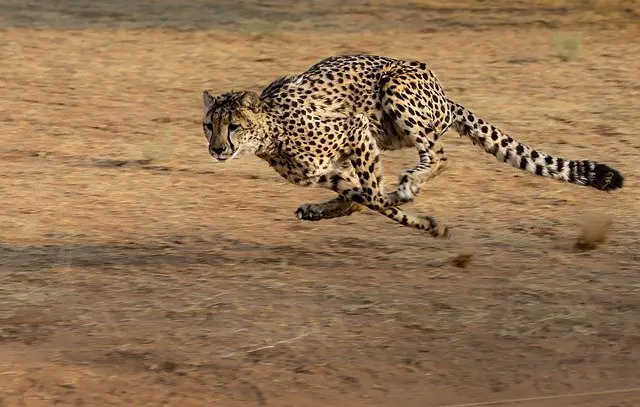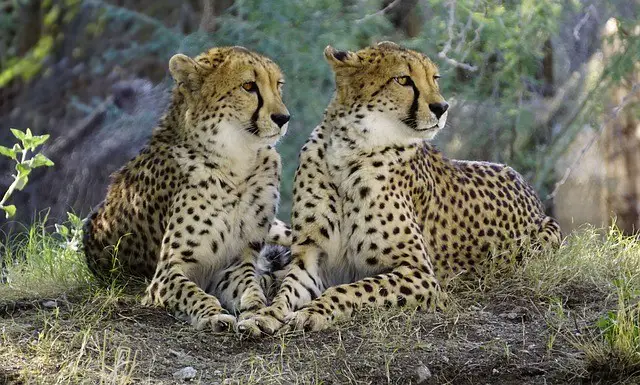The cheetah is the fastest land animal in the world. It runs much faster than every other land animal alive today. We have gathered complete information about the “Cheetah Speed” that will help you in understanding not only “How Fast Can A Cheetah Run” but also how do cheetahs run so fast. We have also compared its speed with other animals so that you can have an idea of how much faster it is than other animals along with informative videos.
How Fast Can A Cheetah Run
The simple answer to this question is that a cheetah can run at a speed of 112 to 122 km/h. That’s seriously fast! But here’s the catch: they can only keep up this incredible pace for about 450 meters, or roughly 1500 feet. Imagine that—they go from zero to 100 kilometers per hour in just three seconds! While that’s an amazing burst of speed, they can only maintain it for a short time. It’s like a natural turbo boost that helps them catch their prey before they quickly run out of steam.

How Fast Can a Cheetah Run MPH – Cheetah Speed MPH
In MPH (miles per hour) a cheetah can run at a top speed of 69 to 75 mph. They can maintain this speed for about 0.28 miles. They can hit 60 mph in just three seconds.
How Fast Does a Cheetah Run – Comparatively
When compared to the fastest cars such as Ferrari, Cheetah is as fast as the Ferrari when their acceleration is compared from zero to hundred. Both the Ferrari and the Cheetah can accelerate from zero to 100 in less than three seconds. The maximum speed of a human being is about 45 km/h i.e. 28 miles per hour. So Cheetah when compared to us is 2.7 times faster than us. So there is not even a little chance for us to overrun them.
Cheetah Top Speed – Maximum Speed of Cheetah
Though there is not an exact figure for the Cheetah top speed yet according to various studies where the speed was calculated, the maximum speed of a cheetah is 76 mph i.e. 122 km/h.
Fastest Animal in the World
Due to this high speed, Cheetah holds the record of the fastest running land animal in the world.

How Do Cheetahs Run So Fast
Have you ever wondered how cheetahs manage to be so incredibly fast? It’s all thanks to some amazing physical features they’ve developed over time. Let’s break down the key parts that make cheetahs the speed demons of the animal world.
- First up, the cheetah’s spine is super flexible. This isn’t just any ordinary backbone; it’s like a powerful spring that stretches and contracts as the cheetah runs. This flexibility allows the cheetah to extend its body to the max during a sprint, covering more ground with each stride. It has comparatively long legs with special muscles and an exceptionally flexible spine that enables it to take large strides of about 8 meters i.e. 25 feet.
- The adaptations of a cheetah such as a small head, slender body, and rib cage that is flatter than other animals. This helps it in attaining an aerodynamic shape.
- Compared to its size, it weighs less i.e. about 55 kg, making it ideal for high speed.
- Next, take a look at their nostrils. They’re big and wide, which might not sound glamorous, but it’s crucial for speed. These large nostrils allow the cheetah to take in a lot of air quickly, feeding oxygen to their muscles during those high-speed chases. This efficient breathing system to keep it oxygenated at high speeds. Deep airflow and good oxygen levels are maintained during high speeds due to its wide nostrils, large heart, and large lungs.
- And speaking of muscles, the cheetah’s leg muscles are something else! They’re incredibly strong and built for speed rather than endurance. These muscles power each explosive push off the ground, helping the cheetah accelerate faster than any other land animal.
- It has a long tail which helps in making sharp turns during high speeds.
- Its feet are hard and ridged with nonretractable claws providing it extra grip over the ground.
- When chasing its prey, the heart beats at an incredibly high rate allowing it to attain such high speed. The heart can maintain this high beat rate only for 10 seconds and after this, the cheetah is too hot or too tired to move. Cheetahs always need to rest after chasing their prey.
Fastest Cheetah on Earth
The fastest Cheetah on Earth is a female Cheetah named Sarah. It lives in Cincinnati Zoo, Ohio, USA. It ran 100 meters dash in 5.95 seconds and reached a top speed of 61 mph. Usain Bolt, the fastest human runner from Jamaica ran 100 meters dash in 9.58 seconds in the 2012 Olympics.
Comparative Analysis
When we talk about speed in the animal kingdom, cheetahs are often the stars of the show. But how do they stack up against other speedy creatures? Let’s dive in and compare!
Cheetahs are the undisputed sprint champions, clocking in at speeds up to 60-70 miles per hour. This incredible speed lets them catch prey like gazelles in just a few seconds. But they’re not the only fast animals out there.
Take the peregrine falcon, for example. While it’s not running on land, this bird hits astonishing speeds of over 200 miles per hour during its hunting dive. It’s like a feathered missile!
Then there’s the pronghorn antelope, North America’s speedster, which can run at 55 miles per hour. Unlike cheetahs, pronghorns can maintain their speed for much longer, making them marathon runners of the plains.
And don’t forget the sailfish, the fastest swimmer in the ocean, reaching speeds of up to 68 miles per hour. It’s a real aquatic bullet!
Each of these animals has adapted their speed for survival, whether it’s catching dinner or escaping predators. The cheetah’s burst of speed is unmatched for short distances, but in the vast tapestry of nature, every creature has its unique edge.
Top 10 Fastest Creatures on Earth
- Peregrine Falcon 242 mph
- Golden Eagle 200 mph
- Spine-tailed Swift 106 mph
- Frigate Bird 95 mph
- Spur Winged Goose 88.23 mph
- Cheetah 75 mph
- Sail Fish 68.35 mph
- Pronghorn Antelope 55 mph
- Marlin Fish 50 mph
- Blue Wildebeest 50 mph
Behavioral Context
Ever wonder how a cheetah uses its incredible speed in the wild? It’s all about the hunt. A cheetah’s speed isn’t just for show; it’s a critical tool for survival.
When a cheetah spots potential prey, it doesn’t just charge in. Instead, it uses a mix of stealth and strategy, sneaking up as close as possible. Then, in a burst of speed, it dashes towards its target. This high-speed chase is intense but short-lived. Cheetahs are sprinters, not marathon runners, so they need to catch their prey quickly, usually within a minute, or they have to give up due to exhaustion.
This strategy is pretty effective, but it’s not foolproof. Only about half of these lightning-fast chases result in a meal. That might not sound like a lot, but in the animal world, that’s a pretty good success rate. It shows just how well the cheetah’s speed is adapted to its hunting lifestyle, helping it thrive in environments where quick bursts of speed can make the difference between feasting and famine.
Conservation Status
Cheetahs are not just the fastest land animals; they’re also among the most vulnerable. Classified as “Vulnerable” on the IUCN Red List, cheetahs face several threats that impact their numbers and their freedom to roam and run.
Habitat loss is a big challenge for cheetahs. As their natural environments shrink due to human activities like agriculture and urbanization, cheetahs lose the vast, open spaces they need for their high-speed chases. This not only makes it harder for them to hunt but also leads to conflicts with humans, as cheetahs sometimes venture into farmlands looking for food.
Conservation efforts are crucial to ensure that cheetahs have the space to run and thrive. Protecting their habitats and creating corridors between protected areas can help maintain their natural behaviors and improve their chances of survival. By understanding the importance of these majestic creatures and their need for space, we can help secure a future where cheetahs continue to race across the plains.
Do want to learn more interesting facts about Cheetah: Cheetah Facts for Kids





